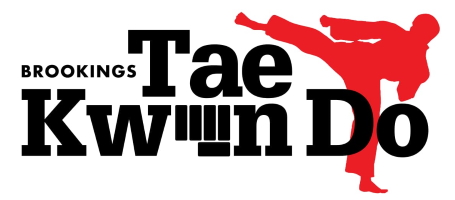Curriculum
Brookings Tae Kwon Do, LLC uses curriculum of Tae Kwon Do Chung Do Kwan style of martial arts from Korea. Brookings Tae Kwon Do teaches Tae Geuk Poomse (Forms) for Gup Rank (Color Belts) promotions and Black Belt Poomses of Koryo and so forth.
Upon achieving the rank of 1st Dan, students gain the opportunity to become Kukkiwon Certified which is an international recognition of Black belt Rank. Although it is not required, it is highly recommended.
A students path, whether the student is a child or adult, is different for each. Brookings Tae Kwon Do strives to teach taditional Tae Kwon Do and practical self-defense. We make all aspects of training available to everyone of all ages. Please click on the tabs to the left in order to learn more about what each Gup Rank is and expectations required for promotion. Anyone can earn a black belt. Our school will not give you a black belt, it must be earned through hard work, dedication and perserverance.
Bowing
Bowing can be considered the ultimate symbol of respect — it is considered a reflection of respect from the soul. In ancient times, when warriors approached on another, they bowed. They may have been friends or enemies, or they may have not known one another at all. Nevertheless, they bowed just the same, for each was guardedly cautious of the other’s potential fighting prowess. What the bow did signify, and still does today, was the mutual respect they shared for each other.
Bow before beginning any type of basic exercise or poomse. Always bow to your instructor when beginning and ending instruction, and instructors will always bow to their students at the same time. (Students bow to each other whenever beginning any type of sparring).
When students bow to their instructor, they are expressing sincere appreciation for the training they have received from that senior instructor. Students on the training floor are to bow when the instructor enters the Do Jong (training area) for the first time prior to the beginning of a training session. The first to notice the instructor on the floor will call the students to attention and give the command to bow. Students will stand at the position of attention until given further instruction.
Come to attention and bow when approaching or when approached by a senior rank student or black belt. It is a sign of respect to address a senior member or black belt as “sir” or “ma’am” when speaking to them.
The Do Jong
The Do Jong is the Korean term for the training area. When entering the Do Jong, always remove your shoes. This is for both practical and traditional purposes. The symbolism of learving your shoes at the door represents the students’ and instructor’s ability to leave their problems at the door, in their shoes. Tae Kwon Do is practiced in bare feet for several reasons. To promote balance and coordination, to help prevent injury, to keep the training area clean, and to condition and strengthen the feet and ankles.
Anywhere in uniform, students should always maintain proper posture; never lean against a wall, whether seated or standing. When in uniform, never sit any place except on the floor, unless directed otherwise by the instructor in charge.
Keep these simple guidelines in mind when entering any Do Jong:
• Keep yourself and your uniform clean.
• Do not wear jewelry, and keep fingernails and toenails short and clean.
• Always show dedication and discipline.
• Always act with proper etiquette and good moral judgment.
• Do not bring food or gum into the training area.
• Help lower ranking students.
• Follow the instructions of higher ranking students.
• Follow the instructions of the instructor and the assistant instructors.
• Do not leave class without permission.
• Come to class on time.
• Inform the school of absence.
• Always dress in a proper uniform in good condition.
• Help keep the school clean.
• Pay tuition on time.
Appearance and Uniform Code
There are times when wearing the uniform is required and there are circumstances when wearing it is inappropriate and prohibited.
The formal training uniform may be worn in the following circumstances:
• Whenever practicing Tae Kwon Do.
• It is preferred that the training uniform not be worn when traveling to and from a training site, but under circumstances when it is, the belt is to be folded, draped around the neck, and ends tucked into the do bok top. The belt is to be worn during Tae Kwon Do activities only.
• Whenever authorized by your instructor, if different from above.
The formal training uniform may not be worn:
• As a costume.
• While playing or socializing or for any reason other than to promote the art of Tae Kwon Do.
